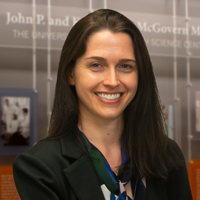Biography
Dr. Stavoe earned a BS in Biochemistry/Molecular Biology/Biotechnology and a BA in French from Michigan State University. Dr. Stavoe completed her graduate work with Dr. Daniel Colón-Ramos at Yale University, obtaining MPhil and PhD degrees in Cell Biology. Her thesis work used C. elegans to investigate the molecular mechanisms that instruct synaptic vesicle clustering during neurodevelopment. As a postdoctoral fellow in Dr. Erika Holzbaur’s lab at the University of Pennsylvania, she examined the molecular mechanisms that contribute to an age-related decrease in autophagosome biogenesis in neurons. During her postdoctoral studies, Dr. Stavoe was awarded a F32 postdoctoral training fellowship, as well as the prestigious “NIH Pathways to Independence Award” (K99/R00), both from NINDS. Dr. Stavoe joined the Department of Neurobiology and Anatomy at the McGovern Medical School at UTHealth in September 2020 and was awarded a Rising STAR Award from the UT system.
Areas of Interest
Research Interests
The Stavoe lab is interested in understanding how neurons maintain their homeostasis and integrity to survive the lifetime of the organism in which they live. For humans, this can mean 80+ years, but for longer-lived animals, like Galapagos tortoises and Greenland sharks, neurons might have to survive 200-400 years. The unique characteristics of neurons (their polarity, high metabolic load, and that they are post-mitotic) present additional challenges to maintaining longevity.
The Stavoe lab is particularly interested in the role of autophagy, a degradative pathway, in neurons during aging and neurodegeneration. Misregulation of autophagy has been implicated in the major age-related neurodegenerative diseases (Alzheimer’s, Parkinson’s, and Huntington’s diseases, and ALS) and neuron-specific depletion of critical autophagy genes causes neurodegeneration in mice.
We aim to identify and understand how autophagy is exquisitely regulated in neurons so that we can modulate neuronal autophagy, aspiring to provide therapeutic targets for neurodegenerative diseases. We identify the molecular mechanisms that control neuronal autophagy, both temporally and spatially in the neuron. In addition, we examine the different stages of autophagy, from autophagosome biogenesis to degradation of contents, to understand how the entire autophagy pathway changes in neurons with age. The Stavoe lab uses advanced, multi-color, live-cell and live-animal microscopy, in addition to biochemical, molecular biology, and genetic techniques to answer these questions. We use primary neuron culture from mice, complemented with the genetic tractability and in vivo imaging feasibility of C. elegans.
Publications
Peer-reviewed research articles
- Stavoe, AKH and Holzbaur, ELF. Maturation of neuronal autophagosomes is altered with age. In preparation.
- Stavoe, AKH, Gopal, PP, Gubas, A, Tooze, SA, and Holzbaur, ELF. Expression of WIPI2B counteracts age-related decline in autophagosome biogenesis in neurons. eLife. 2019. 8:e44219. Featured in the Philadelphia Inquirer. “A new front in preventing brain disease.” September 1, 2019. Featured in PennMedicine News. “Taking out the Protein Garbage Becomes More Difficult as Neurons Age.” July 18, 2019
- Stavoe, AKH, Hill, SE, Hall, DH, and Colón-Ramos, DA. KIF1A/UNC-104 transports ATG-9 to regulate neurodevelopment and autophagy at synapses. Dev Cell. 2016. 38(2):171-185.
- Larkin, RM, Stefano, G, Ruckle, ME, Stavoe, AKH, Sinkler, CA, Brandizzi, F, Malmstrom, CM, Osteryoung, KW. REDUCED CHLOROPLAST COVERAGE genes from Arabidopsis thaliana help to establish the size of the chloroplast compartment. Proc Natl Acad Sci. 2016. 113(8):E1116-25.
- Stavoe, AKH, Nelson, JC, Martínez-Velázquez, LA, Klein, M, Samuel, ADT, and Colón-Ramos, DA. Synaptic vesicle clustering requires a distinct MIG-10/Lamellipodin isoform and ABI-1 downstream from Netrin. Genes and Development. 2012. 26(19):2206-21.
- Stavoe, AKH and Colón-Ramos, DA. Netrin instructs presynaptic assembly through Rac GTPase, MIG-10/Lamellipodin and the actin cytoskeleton. Journal of Cell Biology. 2012. 197(1):75-88.
Reviews and commentaries
- Stavoe, AKH and Holzbaur, ELF. Neuronal autophagy declines substantially with age and is rescued by overexpression of WIPI2. Autophagy. 2020. 16(2):371-372.
- Stavoe, AKH and Holzbaur, ELF. Autophagy in neurons. Annual Review of Cell and Developmental Biology. 2019. 35:477-500.
- Stavoe, AKH and Holzbaur, ELF. Axonal autophagy: Mini-review for autophagy in the CNS. Neurosci Lett. 2019. 697:17-23.
- Stavoe, AKH and Holzbaur, ELF. What Doesn’t Kill You Makes You Stronger. Developmental Cell. 2018. 47(4):402-403.
- Nelson, JC*, Stavoe, AKH*, and Colón-Ramos, DA. The actin cytoskeleton in presynaptic assembly. Cell Adhesion & Migration. 2013. 7(4):379-387. *These authors contributed equally
Book Chapter
Stavoe, AKH and Holzbaur, ELF. Live Imaging of Autophagosome Biogenesis and Maturation in Primary Neurons. “Imaging and Quantifying Neuronal Autophagy,” Neuromethods, Springer Nature Series. 2019. In press.
